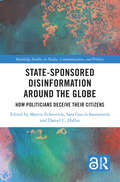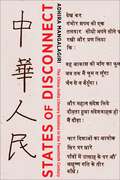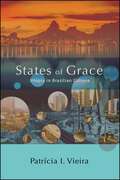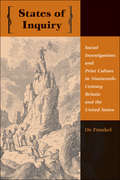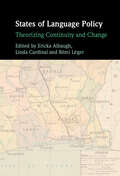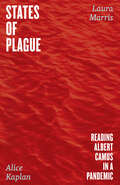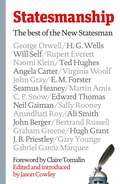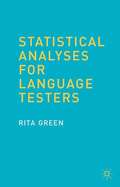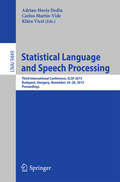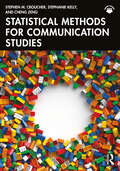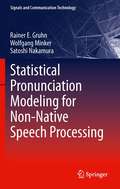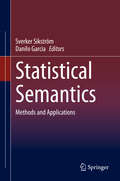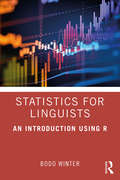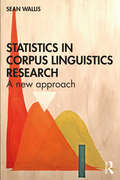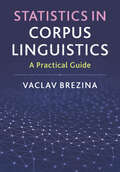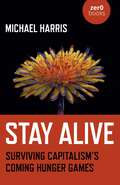- Table View
- List View
State-Sponsored Disinformation Around the Globe: How Politicians Deceive their Citizens (Routledge Studies in Media, Communication, and Politics)
by Martin Echeverría, Sara García Santamaría and Daniel C. HallinThis book explores the pervasive and globalised trajectory of domestic disinformation. It describes specific operations and general apparatuses of disinformation that are sponsored by the State institutions in several countries around the world, such as governments, political parties, and politicians.With an international team of expert authors, this volume meticulously scrutinises instances of State-sponsored disinformation across a diverse spectrum of 14 countries encompassing Western and Eastern Europe, North and Latin America, Africa, Asia, and the Middle East. It examines how political landscapes amplify or constrain disinformation, advancing a comprehensive understanding of its dynamics in the contemporary global milieu. The book is organised in three sections that gather case studies from democratic, non-democratic, and transitional regimes.Advancing the field of misinformation and disinformation studies by specialising in State-sponsored operations and their consequences, this book will be an essential volume for scholars and upper-level students of media and communication studies, journalism, political communication, disinformation and misinformation, social media, sociology, and international politics.The Open Access version of this book, available at http://www.taylorfrancis.com, has been made available under a Creative Commons [Attribution-Non Commercial-No Derivatives (CC-BY-NC-ND)] 4.0 license
States of Disconnect: The China-India Literary Relation in the Twentieth Century
by Adhira MangalagiriIn an interconnected world, literature moves through transnational networks, crosses borders, and bridges diverse cultures. In these ways, literature can bring people closer together. Today, as hopes for globalization wane and exclusionary nationalism is on the march, can literature still offer new ways of relating with others? Comparative literature has long been under the spell of circulation, contact, connectivity, and mobility—what if it instead sought out their antitheses?States of Disconnect examines the breakdown of transnationalism through readings of literary texts that express aversion to pairing ideas of China and India. Focusing on practices of comparison, Adhira Mangalagiri considers how these texts articulate the undesirability or impossibility of relating with national others, tracing portrayals of violence, silence, and distance. She proposes the concept of “disconnect”: a crisis of transnationalism perceptible in moments when a connection is severed, interrupted, or disavowed. Despite their apparent insularity, texts of disconnect offer possibilities for relating ethically across national borders while resisting both narrow nationalisms and globalized habits of thought. Reading a variety of largely untranslated twentieth-century Chinese and Hindi short stories, novels, and poems, Mangalagiri develops three new strategies for comparison—friction, ellipses, and contingency—that together comprise a critical vocabulary of disconnect. Foregrounding transnationalism’s discontents, States of Disconnect offers a different path by which literary texts can cultivate a critical sensibility for making sense of a world rife with division.
States of Grace: Utopia in Brazilian Culture (SUNY series in Latin American and Iberian Thought and Culture)
by Patrícia I. VieiraStates of Grace offers a novel approach to the study of Brazilian culture through the lens of utopianism. Patrícia I. Vieira explores religious and political writings, journalistic texts, sociological studies, and literary works that portray Brazil as a utopian "land of the future," where dreams of a coming messianic age and of social and political emancipation would come true. The book discusses crucial utopian moments such as the theological-political utopia proposed by Jesuit Priest Antônio Vieira; matriarchal utopias, like the egalitarian society of the Amazons; work-free utopias that abolished the boundaries separating toil and play; and ecological utopias, where humans and nonhumans coexist harmoniously. The uniqueness of the book's approach lies in rethinking the link between messianic and utopian texts, as well as the alliances forged between progressive religious, socioeconomic, political, and ecological ideas.
States of Inquiry: Social Investigations and Print Culture in Nineteenth-Century Britain and the United States (New Studies in American Intellectual and Cultural History)
by Oz FrankelIn the mid-nineteenth century, American and British governments marched with great fanfare into the marketplace of knowledge and publishing. British royal commissions of inquiry, inspectorates, and parliamentary committees conducted famous social inquiries into child labor, poverty, housing, and factories. The American federal government studied Indian tribes, explored the West, and investigated the condition of the South during and after the Civil War.Performing, printing, and then circulating these studies, government established an economy of exchange with its diverse constituencies. In this medium, which Frankel terms "print statism," not only tangible objects such as reports and books but knowledge itself changed hands. As participants, citizens assumed the standing of informants and readers. Even as policy investigations and official reportage became a distinctive feature of the modern governing process, buttressing the claim of the state to represent its populace, government discovered an unintended consequence: it could exercise only limited control over the process of inquiry, the behavior of its emissaries as investigators or authors, and the fate of official reports once issued and widely circulated.This study contributes to current debates over knowledge, print culture, and the growth of the state as well as the nature and history of the "public sphere." It interweaves innovative, theoretical discussions into meticulous, historical analysis.
States of Language Policy: Theorizing Continuity and Change
by Linda Cardinal Ericka Albaugh Rémi LégerWhy do some countries have one official language while others have two or more? Why do Indigenous languages have official status in some countries but not others? How do we theorize about continuity and change when we explain state language policy choices? Combining both the theory and practice of language regimes, this book explains how the relationship between language, politics, and policy can be studied. It brings together a globally representative team of scholars to look at the patterns of continuity and change, the concept of state traditions, and notions of historical legacies, critical juncture, path dependency, layering, conversion, and drift. It contains in-depth case studies from a multitude of countries including Algeria, Burkina Faso, Canada, Hong Kong, India, Norway, Peru, Ukraine, and Wales, and across both colonial and postcolonial contexts. Wide-ranging yet accessible, it is essential reading for practitioners and scholars engaged in the theory and practice of language policies.
States of Plague: Reading Albert Camus in a Pandemic
by Alice Kaplan Laura MarrisStates of Plague examines Albert Camus’s novel as a palimpsest of pandemic life, an uncannily relevant account of the psychology and politics of a public health crisis. As one of the most discussed books of the COVID-19 crisis, Albert Camus’s classic novel The Plague has become a new kind of literary touchstone. Surrounded by terror and uncertainty, often separated from loved ones or unable to travel, readers sought answers within the pages of Camus’s 1947 tale about an Algerian city gripped by an epidemic. Many found in it a story about their own lives—a book to shed light on a global health crisis. In thirteen linked chapters told in alternating voices, Alice Kaplan and Laura Marris hold the past and present of The Plague in conversation, discovering how the novel has reached people in their current moment. Kaplan’s chapters explore the book’s tangled and vivid history, while Marris’s are drawn to the ecology of landscape and language. Through these pages, they find that their sense of Camus evolves under the force of a new reality, alongside the pressures of illness, recovery, concern, and care in their own lives. Along the way, Kaplan and Marris examine how the novel’s original allegory might resonate with a new generation of readers who have experienced a global pandemic. They describe how they learned to contemplate the skies of a plague spring, to examine the body politic and the politics of immunity. Both personal and eloquently written, States of Plague uncovers for us the mysterious way a novel can imagine the world during a crisis and draw back the veil on other possible futures.
Statesmanship: The Best of the New Statesman, 1913-2019
by VariousNo British periodical or weekly magazine has a richer and more distinguished archive than The New Statesman, which has long been at the centre of British political and cultural life. Some astonishing things were first published in its pages: great poems such as W.B. Yeats' "Easter 1916"and Edward Thomas's "Adlestrop"; H.G. Wells' interview with Stalin in 1934; C.P. Snow's "Two Cultures" essay; Christopher Hitchens' final interview, conducted by Richard Dawkins; and Hugh Grant's "The bugger bugged".Most of the great political and cultural writers of the recent past have written for The New Statesman. Many have been on its staff or were associates of it: George Bernard Shaw, John Maynard Keynes, V.S. Pritchett, Paul Johnson and John Gray. The most significant intellectual and cultural currents of the age ripple through its pages. Many of the radical causes of our times were launched in association with or in the pages of The New Statesman. For example, the Campaign for Nuclear Disarmament (CND) and Charter 88. There is, too, a rich history of illustration and cartoons to draw on, from Low's sketches of the great and the good to the gonzo art of Ralph Steadman and Will Self's early comic strips.The book is more than an anthology. It tells the story of the New Statesman, from the eve of the First World War to the long aftermath of 9/11 and the Great Recession through which we are still passing. It looks forward as well as back, offering a unique and unpredictable perspective on the world.
Statesmanship: The Best of the New Statesman, 1913-2019
by VariousNo British periodical or weekly magazine has a richer and more distinguished archive than The New Statesman, which has long been at the centre of British political and cultural life. Some astonishing things were first published in its pages: great poems such as W.B. Yeats' "Easter 1916"and Edward Thomas's "Adlestrop"; H.G. Wells' interview with Stalin in 1934; C.P. Snow's "Two Cultures" essay; Christopher Hitchens' final interview, conducted by Richard Dawkins; and Hugh Grant's "The bugger bugged".Most of the great political and cultural writers of the recent past have written for The New Statesman. Many have been on its staff or were associates of it: George Bernard Shaw, John Maynard Keynes, V.S. Pritchett, Paul Johnson and John Gray. The most significant intellectual and cultural currents of the age ripple through its pages. Many of the radical causes of our times were launched in association with or in the pages of The New Statesman. For example, the Campaign for Nuclear Disarmament (CND) and Charter 88. There is, too, a rich history of illustration and cartoons to draw on, from Low's sketches of the great and the good to the gonzo art of Ralph Steadman and Will Self's early comic strips.The book is more than an anthology. It tells the story of the New Statesman, from the eve of the First World War to the long aftermath of 9/11 and the Great Recession through which we are still passing. It looks forward as well as back, offering a unique and unpredictable perspective on the world.
Statistical Analyses for Language Testers
by Rita GreenProvides a step-by-step approach to the most useful statistical analyses for language test developers and researchers using IBM SPSS, Winsteps and Facets. It contains clearly-worked out examples for each analysis with detailed explanations.
Statistical Deception at Work (Routledge Communication Series)
by John MauroWritten to reveal statistical deceptions often thrust upon unsuspecting journalists, this book views the use of numbers from a public perspective. Illustrating how the statistical naivete of journalists often nourishes quantitative misinformation, the author's intent is to make journalists more critical appraisers of numerical data so that in reporting them they do not deceive the public. The book frequently uses actual reported examples of misused statistical data reported by mass media and describes how journalists can avoid being taken in by them. Because reports of survey findings seldom give sufficient detail of methods on the actual questions asked, this book elaborates on questions reporters should ask about methodology and how to detect biased questions before reporting the findings to the public. As such, it may be looked upon as an "elements of style" for reporting statistics.
Statistical Language and Speech Processing
by Carlos Martín-Vide Adrian-Horia Dediu Laurent BesacierThis book constitutes the refereed proceedings of the Second International Conference on Statistical Language and Speech Processing, SLSP 2014, held in Grenoble, France, in October 2014. The 18 full papers presented together with three invited talks were carefully reviewed and selected from 53 submissions. The papers are organized in topical sections on machine translation, speech and speaker recognition, machine learning methods, text extraction and categorization, and mining text.
Statistical Language and Speech Processing
by Carlos Martín-Vide Adrian-Horia Dediu Klára VicsiThis book constitutes the refereed proceedings of theThird International Conference on Statistical Language and Speech Processing,SLSP 2015, held in Budapest, Hungary, in November 2015. The 26 full papers presented together with twoinvited talks were carefully reviewed and selected from 71 submissions. Thepapers cover topics such as: anaphora and coreference resolution; authorshipidentification, plagiarism and spam filtering; computer-aided translation;corpora and language resources; data mining and semantic Web; informationextraction; information retrieval; knowledge representation and ontologies;lexicons and dictionaries; machine translation; multimodal technologies;natural language understanding; neural representation of speech and language;opinion mining and sentiment analysis; parsing; part-of-speech tagging;question-answering systems; semantic role labelling; speaker identification andverification; speech and language generation; speech recognition; speechsynthesis; speech transcription; spelling correction; spoken dialogue systems;term extraction; text categorisation; text summarisation; and user modeling.
Statistical Methods for Communication Science (Routledge Communication Series)
by Andrew F. HayesStatistical Methods for Communication Science is the only statistical methods volume currently available that focuses exclusively on statistics in communication research. Writing in a straightforward, personal style, author Andrew F. Hayes offers this accessible and thorough introduction to statistical methods, starting with the fundamentals of measurement and moving on to discuss such key topics as sampling procedures, probability, reliability, hypothesis testing, simple correlation and regression, and analyses of variance and covariance. Hayes takes readers through each topic with clear explanations and illustrations. He provides a multitude of examples, all set in the context of communication research, thus engaging readers directly and helping them to see the relevance and importance of statistics to the field of communication.Highlights of this text include:*thorough and balanced coverage of topics;*integration of classical methods with modern "resampling" approaches to inference;*consideration of practical, "real world" issues;*numerous examples and applications, all drawn from communication research;*up-to-date information, with examples justifying use of various techniques; and*a CD with macros, data sets, figures, and additional materials.This unique book can be used as a stand-alone classroom text, a supplement to traditional research methods texts, or a useful reference manual. It will be invaluable to students, faculty, researchers, and practitioners in communication, and it will serve to advance the understanding and use of statistical methods throughout the discipline.
Statistical Methods for Communication Studies
by Stephen M. Croucher Cheng Zeng Stephanie KellyA step-by-step guide through various stages of data preparation and analysis, this text demonstrates descriptive and inferential statistics in communication studies.This book equips communication students with the tools they need to engage in quantitative research, ensuring that they understand why the statistical tools they chose are most appropriate for their data. Using examples and data directly relevant to communication researchers, this text provides guidance on how to use and interpret SPSS and write up results, with further guidance via free online material in using Excel and R. Instead of focusing on formulas and in-depth mathematics, this book provides a hands-on approach to understanding the theory, practice, and application of statistical methods in communication. In addition to covering the standard statistical tools used to analyze social science data for hypothesis testing (e.g., correlation, regression, ANOVA), it also covers advanced factor-analytic techniques specific to measurement validation as well as data visualization guidance.Ideally suited for statistics or quantitative methods courses in communication studies programs at the advanced and graduate level.Online resources include tutorials on SPSS, Excel, and R for key constructs and practice quizzes for students. Instructors will find an instructor manual and test bank. Please visit www.routledge.com/9781032814872.
Statistical Panic: Cultural Politics and Poetics of the Emotions
by Kathleen WoodwardIn this moving and thoughtful book, Kathleen Woodward explores the politics and poetics of the emotions, focusing on American culture since the 1960s. She argues that we are constrained in terms of gender, race, and age by our culture's scripts for "emotional" behavior and that the accelerating impoverishment of interiority is a symptom of our increasingly media-saturated culture. She also shows how we can be empowered by stories that express our experience, revealing the value of our emotions as a crucial form of intelligence. Referring discreetly to her own experience, Woodward examines the interpenetration of social structures and subjectivity, considering how psychological emotions are social phenomena, with feminist anger, racial shame, old-age depression, and sympathy for non-human cyborgs (including robots) as key cases in point. She discusses how emerging institutional and discursive structures engender "new" affects that in turn can help us understand our changing world if we are attentive to them--the "statistical panic" produced by the risk society, with its numerical portents of disease and mortality; the rage prompted by impenetrable and bloated bureaucracies; the brutal shame experienced by those caught in the crossfire of the media; and the conservative compassion that is not an emotion at all, only an empty political slogan. The orbit of Statistical Panic is wide, drawing in feminist theory, critical phenomenology, and recent theories of the emotions. But at its heart are stories. As an antidote to the vacuous dramas of media culture, with its mock emotions and scattershot sensations, Woodward turns to the autobiographical narrative. Stories of illness--by Joan Didion, Yvonne Rainer, Paul Monette, and Alice Wexler, among others--receive special attention, with the inexhaustible emotion of grief framing the book as a whole.
Statistical Pronunciation Modeling for Non-Native Speech Processing
by Wolfgang Minker Rainer E. Gruhn Satoshi NakamuraIn this work, the authors present a fully statistical approach to model non--native speakers' pronunciation. Second-language speakers pronounce words in multiple different ways compared to the native speakers. Those deviations, may it be phoneme substitutions, deletions or insertions, can be modelled automatically with the new method presented here. The methods is based on a discrete hidden Markov model as a word pronunciation model, initialized on a standard pronunciation dictionary. The implementation and functionality of the methodology has been proven and verified with a test set of non-native English in the regarding accent. The book is written for researchers with a professional interest in phonetics and automatic speech and speaker recognition.
Statistical Semantics: Methods and Applications
by Danilo Garcia Sverker SikströmThis book discusses the application of various statistical methods to texts, rather than numbers, in various fields in behavioral science. It proposes an approach where quantitative methods are applied to data whereas previously such data were analyzed only by qualitative research methods. To emphasize the quantitative aspects of semantics, and the possibilities of conducting scientific interferences, the book introduces the concept of statistical semantics and presents the reader with a subset of techniques found in that domain. More specifically, the book focuses on methods that allow the investigation of semantic relationships between words, based on empirical corpus data. It shows the reader how to apply various statistical methods on texts, for example statistical tests to ascertain whether two sets of text are statistically different, ways to predict variables from text, as well as how to summarize and graphically illustrate texts. Thus, the book presents an accessible hands-on introduction to a selection of techniques, indispensable for cognitive psychologists, linguists, and social psychologists.
Statistics for Linguists: An Introduction Using R
by Bodo WinterStatistics for Linguists: An Introduction Using R is the first statistics textbook on linear models for linguistics. The book covers simple uses of linear models through generalized models to more advanced approaches, maintaining its focus on conceptual issues and avoiding excessive mathematical details. It contains many applied examples using the R statistical programming environment. Written in an accessible tone and style, this text is the ideal main resource for graduate and advanced undergraduate students of Linguistics statistics courses as well as those in other fields, including Psychology, Cognitive Science, and Data Science.
Statistics in Corpus Linguistics Research: A New Approach
by Sean WallisTraditional approaches focused on significance tests have often been difficult for linguistics researchers to visualise. Statistics in Corpus Linguistics Research: A New Approach breaks these significance tests down for researchers in corpus linguistics and linguistic analysis, promoting a visual approach to understanding the performance of tests with real data, and demonstrating how to derive new intervals and tests. Accessibly written, this book discusses the ‘why’ behind the statistical model, allowing readers a greater facility for choosing their own methodologies. Accessibly written for those with little to no mathematical or statistical background, it explains the mathematical fundamentals of simple significance tests by relating them to confidence intervals. With sample datasets and easy-to-read visuals, this book focuses on practical issues, such as how to: • pose research questions in terms of choice and constraint; • employ confidence intervals correctly (including in graph plots); • select optimal significance tests (and what results mean); • measure the size of the effect of one variable on another; • estimate the similarity of distribution patterns; and • evaluate whether the results of two experiments significantly differ. Appropriate for anyone from the student just beginning their career to the seasoned researcher, this book is both a practical overview and valuable resource.
Statistics in Corpus Linguistics: A Practical Guide
by Vaclav BrezinaDo you use language corpora in your research or study, but find that you struggle with statistics? This practical introduction will equip you to understand the key principles of statistical thinking and apply these concepts to your own research, without the need for prior statistical knowledge. The book gives step-by-step guidance through the process of statistical analysis and provides multiple examples of how statistical techniques can be used to analyse and visualise linguistic data. It also includes a useful selection of discussion questions and exercises which you can use to check your understanding. The book comes with a Companion website, which provides additional materials (answers to exercises, datasets, advanced materials, teaching slides etc.) and Lancaster Stats Tools online (http://corpora.lancs.ac.uk/stats), a free click-and-analyse statistical tool for easy calculation of the statistical measures discussed in the book.
Statius
by Carole E. NewlandsWith the exception of a poem on the unscripted death of a lion in the Colosseum, Book II of Statius' Silvae is largely domestic in theme. It reflects the more private side of Roman culture, its pleasures, houses, gardens, friendships, and personal losses; it concludes with a provocative tribute to the poet Lucan. Despite its variety, the book is carefully constructed as a unit, and this edition, which is suitable for use with advanced students, puts the book into its context in the history of Greek and Roman poetry. The commentary takes into account the important work done on the text of the Silvae in the past two decades as well as the new perspectives brought to bear on Flavian culture by historians and archaeologists. It explores Statius' use of the short poem as a playful engagement with literary tradition that also reflects changing ideas of Roman cultural identity.
Stay
by John CluteStay gathers together 100,000 words of reviews, plus short fiction by John Clute, and was originally published to coincide with Loncon3 (the 2014 World Science Fiction Convention) at which he was one of the Guests of Honour.Also included is a complete reprint of the text of The Darkening Garden.
Stay
by John CluteStay gathers together 100,000 words of reviews, plus short fiction by John Clute, and was originally published to coincide with Loncon3 (the 2014 World Science Fiction Convention) at which he was one of the Guests of Honour.Also included is a complete reprint of the text of The Darkening Garden.
Stay Alive: Surviving Capitalism's Coming Hunger Games
by Michael HarrisWhen The Hunger Games series began in 2008, many commentators lumped it in with other young adult genre fiction. But The Hunger Games was always more political. It&’s since become the defining story for a generation that&’s grown up with economic crisis and never ending war. An uber-rich ruling class gorge themselves in their gleaming high-tech Capitol, while working people are left behind to survive in exploited districts. Revolution is a forgotten hope kept at bay by brutal policing, aching poverty, and rigid class segregation. Suzanne Collins' dark vision has only become more relevant as The Hunger Games generation are thrown into an arena of increasingly brutal competition from which it seems like there is no escape, amid the climate crisis, global pandemics, rampant inequality, authoritarianism, media misinformation, and violence and cruelty as TV spectacle. It's no wonder the story continues to resonate. Stay Alive uses the story to shed light on our own age of extreme inequalities and climate collapse, in which elites use state power, compliant media, and violent spectacle to pacify their populations. The elite endgame is leading us towards our own version of Panem, an authoritarian state order we&’ll call Capitolism. The world is catching fire. Elites have no intention of burning with us. And yet there is hope, which Michael Harris finds for his readers in revolution and radical solidarity, in the anti-authoritarian, empathetic, cooperative politics of a generation that has no choice but to rebel.
